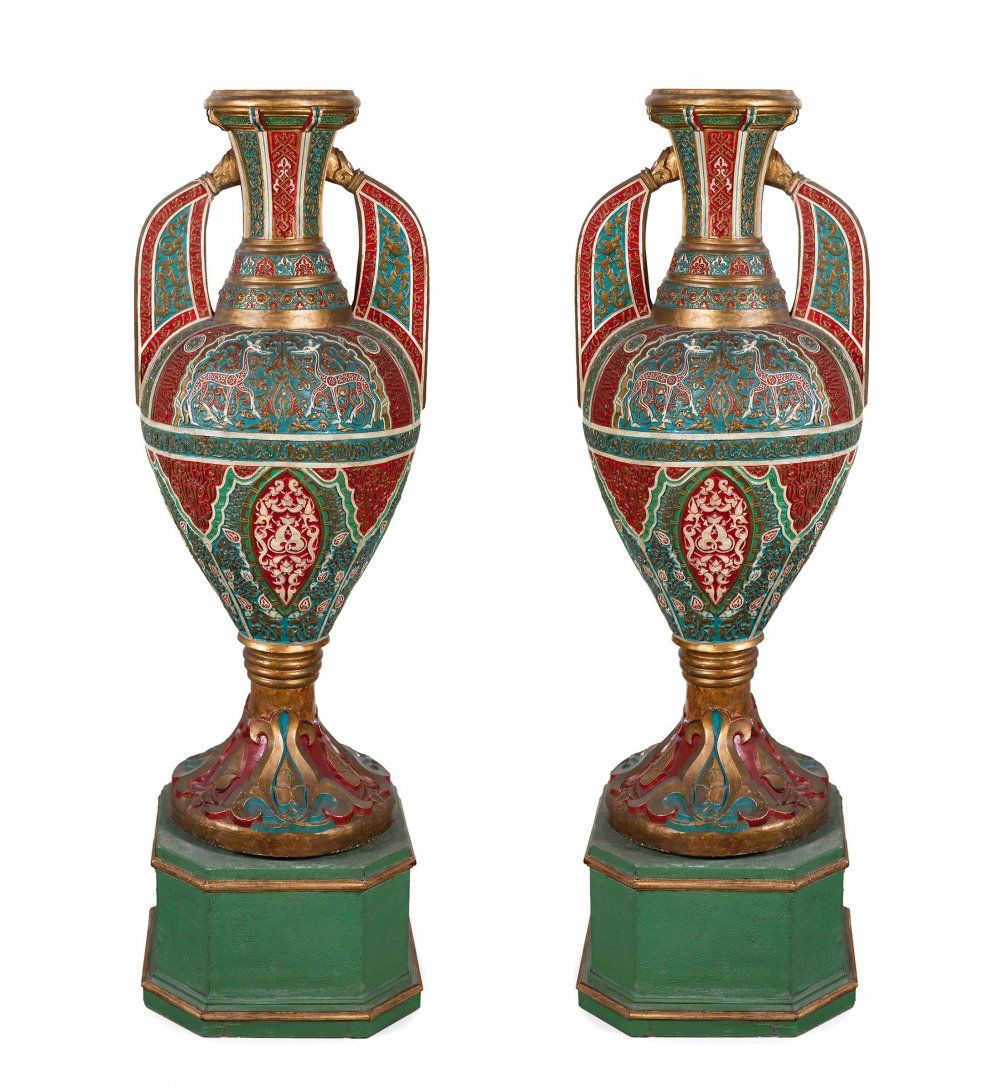Description
Pair of Nasrid style vases. Granada, second half of the 19th century. Polychrome stucco on wooden base. Measurements: 125 cm (vase height) x 31 cm (base height) x 50 cm (vase diameter). Nasrid ceramics was born as an artistic expression, as well as a commercial product in Malaga, after the foundation of the first Nasrid kingdom, also known as the Emirate of Granada, a period in which these territories were ruled by the Muslim people. The Nasrid pottery quickly gained great importance among the kingdoms of Spain, as after the decline of ceramic production in Murcia and Almería, as well as the impulse given by the first great ruler, taking advantage of his relationship with Fernando III of Castile, this pottery grew in popularity gaining ground in uses beyond simple vases. The name 'Alhambra-type vase' refers to a type of luxury piece typical of the Nasrid period, monumental vases designed to decorate theatres and which constitute some of the most spectacular pieces produced by Nasrid craftsmen. The value attached to these great pieces extended beyond the Nasrid period. In the 16th century they were already well-known pieces; in the 18th century the history of these vases began to take shape between reality and legend; and in the 19th century they were objects of interest and collectors' items. As in this case, if there is one thing that characterises Nasrid vases, it is their beauty. Made in the traditional way, they are decorated by hand and are richly coloured. Elegant, tasteful and elaborate are some of their main characteristics. The designs also vary, depending on the vase and what the artist wants to express. However, the quality of the design is truly unsurpassed as they are handmade, using ancient techniques. In addition, high quality materials are used to decorate the vase, which is then sealed to ensure the durability of the design. One of the most popular items in Nasrid ceramics were the Alhambra vases. These vases were produced from the 10th to the 15th century and were considered to be very exclusive luxury objects, initially thought to be ornamental until it was realised that they served as water filters. Their design, with a convex body, wing-like arms and a tall spout, as well as a support to hold the narrow bottom, not only focused on giving the vase a more stylish appearance, but also allowed the water to be filtered more easily. Making the vase was a challenge as it required the use of fire in all three stages of construction, decoration and finishing. Today, some Alhambra vases are preserved in different museums and institutions, although we can find that there are several modern copies made mainly for decorative purposes.
1
Pair of Nasrid style vases. Granada, second half of the 19th century. Polychrome stucco on wooden base. Measurements: 125 cm (vase height) x 31 cm (base height) x 50 cm (vase diameter). Nasrid ceramics was born as an artistic expression, as well as a commercial product in Malaga, after the foundation of the first Nasrid kingdom, also known as the Emirate of Granada, a period in which these territories were ruled by the Muslim people. The Nasrid pottery quickly gained great importance among the kingdoms of Spain, as after the decline of ceramic production in Murcia and Almería, as well as the impulse given by the first great ruler, taking advantage of his relationship with Fernando III of Castile, this pottery grew in popularity gaining ground in uses beyond simple vases. The name 'Alhambra-type vase' refers to a type of luxury piece typical of the Nasrid period, monumental vases designed to decorate theatres and which constitute some of the most spectacular pieces produced by Nasrid craftsmen. The value attached to these great pieces extended beyond the Nasrid period. In the 16th century they were already well-known pieces; in the 18th century the history of these vases began to take shape between reality and legend; and in the 19th century they were objects of interest and collectors' items. As in this case, if there is one thing that characterises Nasrid vases, it is their beauty. Made in the traditional way, they are decorated by hand and are richly coloured. Elegant, tasteful and elaborate are some of their main characteristics. The designs also vary, depending on the vase and what the artist wants to express. However, the quality of the design is truly unsurpassed as they are handmade, using ancient techniques. In addition, high quality materials are used to decorate the vase, which is then sealed to ensure the durability of the design. One of the most popular items in Nasrid ceramics were the Alhambra vases. These vases were produced from the 10th to the 15th century and were considered to be very exclusive luxury objects, initially thought to be ornamental until it was realised that they served as water filters. Their design, with a convex body, wing-like arms and a tall spout, as well as a support to hold the narrow bottom, not only focused on giving the vase a more stylish appearance, but also allowed the water to be filtered more easily. Making the vase was a challenge as it required the use of fire in all three stages of construction, decoration and finishing. Today, some Alhambra vases are preserved in different museums and institutions, although we can find that there are several modern copies made mainly for decorative purposes.
